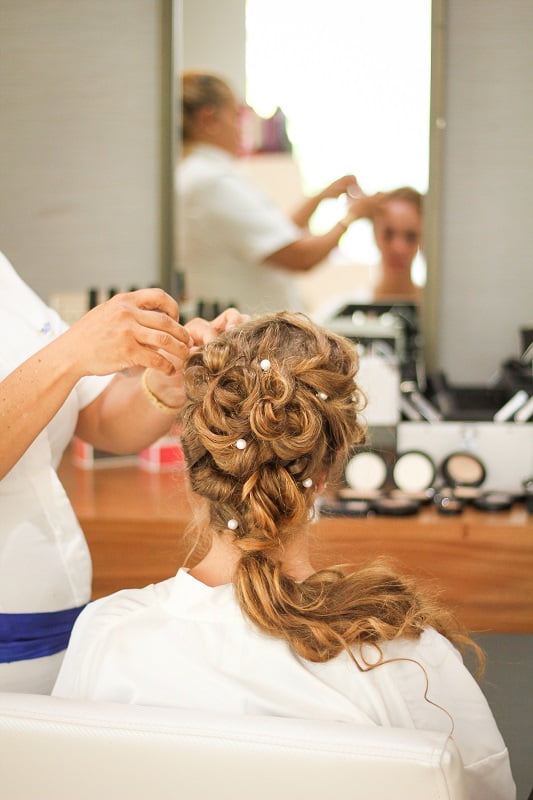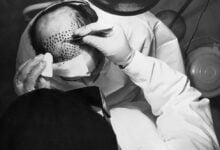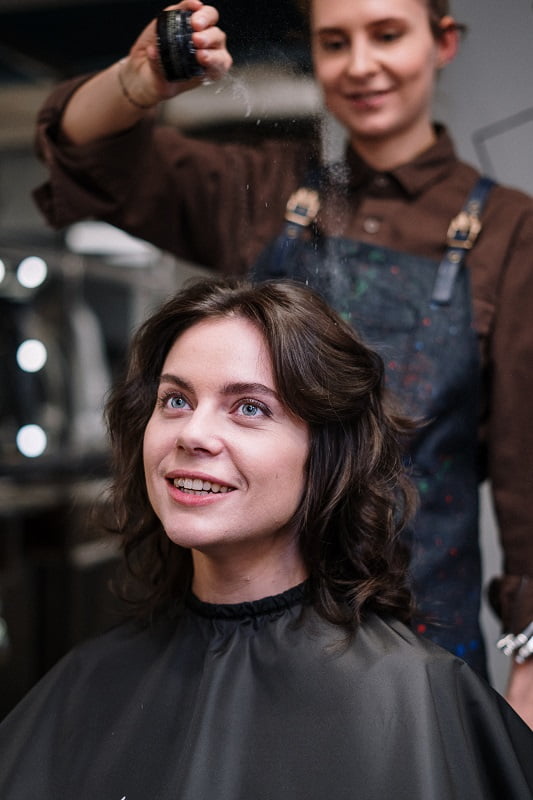Styling Secrets of Hair Transplant

Styling Secrets of Hair Transplant
If you are getting a hair transplant, you probably want to know all about styling methods.
From the days before your surgery to the years afterwards, it is good to know all you can about how to care for your hair. If you did not want your hair to look good, you would not have had the hair transplant in the first place.
When you are having your consultation with the surgeon, explain the kind of hair style you would like to have. This gives him an idea of how best to create the
design of the hair transplant receptor sites on your scalp. It might make a difference in the angle of the hair or the direction of the hair.
The doctor will show you before and after pictures of his past hair transplant patients. Do not be discouraged if they all seem to have the same plain haircut in the after pictures. This is often the case when the doctor is trying to be truthful.
He will have the patients pose with their hair sans hair styling products like mousse or gel. This is to prevent you from getting a false impression of what a hair transplant can do.
Yet, if you use your imagination, you can see how the right style would make the hair transplant look great.
Before you go in for your hair transplant surgery, your surgeon will give you some facts about how to care for your hair before the surgery and after.
He will emphasize that the hair on your crown should be at least 2cm long. This is so that the donor site scar will be adequately covered up until the sutures heal.
Also, the doctor will not tell you to get a haircut. In fact, when getting a hair transplant, the longer your hair is, the better it often works. It hides the sutures and eventually hides any scars you might have.
You will be told to use your normal shampoo before the hair transplant surgery. No special scalp treatment will be needed. Do not worry about any scraggly hair on top of your head. The doctor will blend it in with the grafts as he goes.
It may seem odd, but once the grafted hairs are set, they are just as strong as the rest of your hair. You can cut them, comb and brush them, and even dye them in time.
New hairs start to grow within three months. You will find you need haircuts more often, as your hair will grow about one or two centimeters per month.
As for intense styling, your hairdresser can help you with that in about 20 days after your hair transplant surgery. Your grafted hairs are the same as old hairs but they are balding resistant.
However, they need special care at first. Your hairdresser should know about hair transplants and understand just what you need to avoid.
After a few short weeks, you can treat your hair transplant grafts just like you did your old hair before you lost it. You can style it however you want. You can comb it and use hair care products on it. Do not forget: this is really your own hair.
How Hair Is Inserted in Hair Transplant Surgery
Hair transplant surgery begins, after anesthesia is applied, with removing donor tissue. Follicular units are then extracted from the tissue using a stereomicroscope.
This is all done by skilled nurses and technicians. The insertion of the hair into the receptor sites comes later.
Once the follicular units for the hair transplant are dissected out of the donor tissue, technicians set them aside in a saline solution. The temperature must be ideal or the small grafts will not survive the procedure. This is done very carefully in order to ensure a good result.
The surgeon will make tiny incisions into the scalp where the hair transplant grafts are to go. These are called the receptor sites.
They are made with a very thin surgical needle. The surgeon must have an eye for detail to properly set the receptor sites. He must also be very artistic to achieve a natural look, especially at the hairline.
The direction the hair grows, both on the front of the head and at the crown, are very important, too. The doctor must make the condition of the newly placed hair look like the patient’s own natural scalp hair.
The angle that the hair is put in determines how much it will stand up from the head.
Once the surgeon has made all the hair transplant incisions that lay out the design he has created, the specially trained surgical team steps in.
They use his plan to accomplish his goals, and in turn the goals of the patient. The groundwork is done for them by the surgeon when he does his incisions.
The surgical team takes care to get every hair transplant graft into the receptor sites as they have been laid out. They waste no time, though,
because the small grafts are vulnerable when their follicles are outside of the skin. The goal is to get the grafts in as quickly as possible while staying true to the design.
Next, the doctor looks over the hair transplant for quality control. He may take a good deal of time tweaking the placement of grafts before he
is satisfied that they are all set properly into their receptor sites in a pleasing fashion. When he gives the ok, the surgical technicians again take over the patient’s care.
The grafts will be more permanently set into place when the technicians dry them by blowing a cool blow dryer across them.
This makes them adhere in their place so that no bandages are necessary. The patient will be asked to bring, or will be given, a baseball cap for the ride home from the hair transplant procedure.
The doctor will want to see how the grafts are doing the day following the hair transplant. The patient will go in for a check-up so that
any problems can be corrected quickly. If that is not possible, at least plans can be made to correct them at a future time.
The doctor will have done his job with the hair transplant procedure at this point. All that remains is periodic checkups.
If the hair loss is extensive, there may be more procedures, but all the hair transplant surgeries will be done with the same amount of care.
How Modern Hair Restoration Can Be Successful
Before seeking the services of a hair replacement center, it is important to understand some basic information about hair loss and what can do about it.
Hair Loss Background
Approximately 95% of the estimated 60 million men and women in the United States who experience abnormal hair loss suffer from a hereditary condition called androgentic alopecia.
This is the gradual loss of hair that usually begins somewhere between 30 to 40 years of age in men and is essentially a cosmetic disorder,
which is relevant because most health insurance plans will not pay for cosmetic care. In women, the onset of hereditary hair loss usually does not occur until after menopause.
The incidence of androgentic alopecia is highest in white males but can also be found women, Asians, and African Americans.
Usually, the thinning hair begins in the frontal area and progresses back over the head. In general, the growth transition begins with large, thick healthy hair, then progresses to thinner, shorter, indeterminate hairs, and finally, short, nonpigmented vellus hairs cover the area sporadically.
During this transition, the patient may notice more shedding than normal. Some shedding is natural, as up to 10% of a person’s hair so prone to shedding at any given time. Lab studies can be done to determine whether the hair loss is genetic or caused by other sources.
What can be done about it?
Once the cause of thinning hair is determined, a hair replacement center can offer several viable solutions for hair restoration .
If the cause is not genetic, changes in medication, diet, or hairstyle products may take care of the problem without any significant out-of-pocket cost to the patient.
In the event the patient is loosing hair due to genetic reasons or the changes mentioned above do not create a regrowth of hair, other options are still available.
• Surgery offers a couple of solutions. One is a scalp reduction. This is where a portion of the bald scalp is removed, and then the skin is stretch to cover the area of the scalp where the skin was removed.
The other option is probably the most commonly considered option. Hair follicles can be transplanted from a donor or from thickly haired sections of the head. The main problem with hair plugs is covering the bald area with enough plugs to provide satisfactory results.
• The last option is hair weaving. Hairpieces are weaved into the patient’s natural hair to create a prosthetic method of covering the baldness.
While the hairpieces of the past were often horrendous failures, many of the modern prosthetics are indistinguishable from the patient’s own hair.
Conclusion for modern hair restoration technologies
Now that you have a general idea what to expect from a hair replacement center, you can more effectively prepare a list of questions for the doctor.
You can also go prepared to ask questions about your family history, medical history, current medications, diet, and general hair care regime.
While beauty is in the eye of the beholder, it is also an integral part of self-image. As such, concern over hair loss is a normal reaction and should not be taken lightly.
Hair Transplant Procedures & Costs
Hair loss due to androgenetic alopecia or pattern baldness is a condition that affects both men and women.
Surgical hair transplantation is the only solution for restoring the lost hair in pattern baldness when medical hair restoration does not offer you a good hair re-growth.
If you have well-defined and clearly established areas or patterns of baldness on the crown with healthy dense coverage of hair at the sides and the back of the head, you are probably suitable for a hair transplant surgery.
Hair that is transplanted in the frontal region of the skull generally offers the best results. However, a hair transplant procedure can also be carried out on any other area of your head if you have some bald patch there.
It is best to have detailed information about the hair transplant procedure before you make plans to undergo a surgery.
It is only after you have read through all the information that you can understand and appreciate the significance of surgical hair restoration.
The information will also help you decider whether you are the right candidate for the hair transplant surgery.
Now that you are well informed, you would probably think whether the hair transplantation is at all affordable?
Hair transplant cost varies depending upon your past medical history, the degree and extent of your hair loss, possibility of medical hair restoration as an adjunct for surgical hair restoration,
number of sessions that would will be required for hair transplant surgery, etc. It is after placing due considerations to these factors that your hair restoration surgeon will be able to chalk out an affordable hair transplant treatment plan for you.
Before you make a decision to undergo hair transplant procedure, it is better that you make a consultation visit to the hair transplantation surgeon. This consultation will give you some idea about the hair transplant cost for your surgery.
In general, the average hair transplant cost in USA ranges from $3,690 to $ 9, 800. In some cases it can also be as high as $ 15, 000.
The hair transplant cost varies considerably from person to person, and also depends on how many grafts you need, the number of sessions involved, and the hair transplant center or clinic you visit.
Clinics in California charge more on average than clinics in Texas. Going to Canada or to Mexico for the hair transplant will be cheaper.
Remember that the hair transplant prices should not be the main reason for choosing a particular hair transplant surgeon, though it is an important factor for most patients.
The cost of hair transplant surgery at most hair restoration centers in the USA is based on the size of a hair transplant “session”
not on the number of hair follicle units transplanted. This is simply because some grafts contain more hair follicles than others.
Scope of laser surgery as a hair transplant procedure
For some people, the word laser surgery is synonymous wit the word “state-of-the-art”. With laser surgery permeating almost any branch of surgery it is not very uncommon to think so.
Though laser surgery has shown much promise in other branches of surgery the scene with hair transplant surgery is entirely different.
Not only is laser hair transplant inappropriate for Follicular Unit Transplantation, it is actually detrimental even with different modification of procedure and use of different laser hair settings.
Let’s see the rationale behind the difference between hair transplant surgeries and other surgeries where the use of laser has been of much advantage.
The value of laser surgery lies in its properties of “selective photo-thermolysis” (this is the ability to destroy a specific target without injuring the surrounding tissue).
Hair transplant surgery is different in this regard from other surgeries because of the lack of a target tissue. And when one is using laser hair transplant surgery for channel creation for inserting the grafts, it is actually making use of destructive properties of the laser.
The laser hair restoration surgery literally burns a recipient hole in the skin. The tall claims made by laser companies for a new class of laser causing no thermal damage, is anything but true.
Regardless of the source and the type, a laser is something which causes thermal damage to the tissue by its high energy.
The laser hair restoration technique always leaves surface change and scarring. Not only this, high energy laser beams used for laser hair transplant may damage hairs existing near the implant site because of burning of the surrounding tissue.
But at the same time it is important to keep in mind the use of laser for hair removal is a different case altogether. Since here the destructive property of laser is put to use, it can be a good option being painless and fast.
There is another drawback of laser hair transplant surgery which is more critical. The high energy of laser beam leads to the closing of the blood vessels.
This characteristic feature of the laser beam is useful in other type of surgery where it helps to close wounds and provides quick healing.
But in case of hair transplant surgery, blood supply is very crucial for nourishing the grafts after they are transplanted.
And this is the main concern about a laser hair transplant surgery. Laser assisted transplants either are not able to grow or heal more slowly to have unpredictable growth due to impaired blood flow.
The thermal damage caused by the laser hair restoration to the surrounding tissue destroys the collagen and weakens the elastic support around the newly transplanted grafts.
It also increases the coagulum (clot) around the graft which, in turn, decreases oxygen perfusion and retards healing.
The uniformly created channels created by laser hair transplant surgery lose all its promise when the laser “loosens” the “snug fit”
between the transplanted graft and recipient site. And this is the reason why laser hair restoration results in unpredicted and slow growth of the hair follicle.
The advantage of laser towards decreasing bleeding at the recipient site is also not of much use in case of hair transplantation surgery.
A hair transplantation surgeon can decrease bleeding by the use of precision instruments and better hair transplant procedures more effectively than using a laser beam.
Regardless the hair transplant procedure a hair transplant doctor uses, maximizing the growth of a transplant is the one and only aim of any hair transplant surgery.
And whatever is the type of implanted graft, whether it is a single follicular units or a group of follicular units, restoring the blood supply to the graft is of utmost importance.
And since the laser hair transplant surgery fails to accomplish the vital function of restoring the blood flow, it is to be simply ignored as a hair transplant procedure.
There are many hair transplant centers which boast of laser hair transplant as a painless procedure or as a fast process for hair transplant surgery, are to be totally dismissed.
This is an important piece of information which can save you from a fraudulent hair transplant center if you are planning to have a hair transplant surgery done.
But before you visit a hair transplant clinic find some time to visit the site hairttransplantadvice.com and make an informed decision
hair transplant before and after,hair transplant cost,hair transplant turkey,hair transplant results,hair transplant types,neograft hair transplant,fue hair transplant,hair loss treatment,






